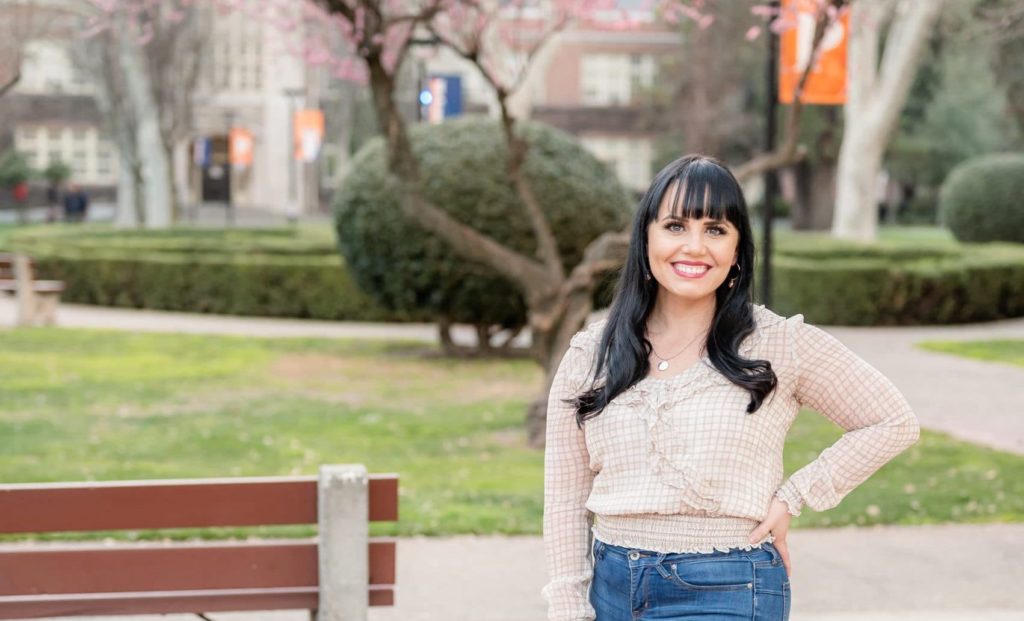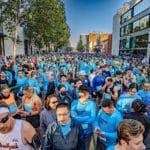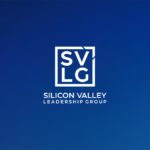When she came to Las Positas College, Destiny Goddu’s original plan was to become a registered nurse.
But when the college’s Veterans Resource Center found out she’d worked on missile guidance lasers for F-18s during her time in the U.S. Marines, another path opened up. They told her about the Vets2Tech program, which is affiliated with Lawrence Livermore National Laboratory. LLNL offered her an opportunity to work in laser research at the National Ignition Facility. Interning there for the summer, Goddu was thrown right into action.
“They let me learn and flourish—it was an incredible experience,” she said.

Creating a pipeline for veterans from the military and other nontraditional students to Silicon Valley tech
Goddu isn’t alone – she’s one of many potential local Silicon Valley tech employees who needed a bridge between their skills and the right workplace.
While the concept of employers as creators of talent is more established in the trades than in tech, Silicon Valley firms are increasingly making use of this age-old model, partnering with local colleges to find and develop talent. At the forefront of this movement is the prestigious Lawrence Livermore National Laboratory in Livermore, CA.
Facing a shortage of engineering talent, in 2014 LLNL partnered with the college of Las Positas, the Alameda County Workforce Board, and the nonprofit Growth Sector to create Vets2Tech, a program helping to train their next generation of engineers and engineering technicians. For the last eight years, Vets2Tech has partnered with Bay Area community colleges to develop math and physics curricula and technology training programs, and then funnel graduates, mostly veterans, into SVLG member companies including LLNL and LAM Research. The program quickly became a win-win for LLNL, LAM and the participating veterans, who had mechanical know-how, leadership skills, and security clearances, but believed they lacked the academic training they needed to succeed in tech.
From Kosovo and Iraq to Las Positas and LLNL

John Clifford Ruiz joined the military right out of high school. After deployments during which he worked in reconnaissance on the frontlines to Kosovo and Iraq, he left the military in 2006 as a sergeant. Despite his skills and experience, after returning home and working his way up in construction, he found that his lack of a degree was a roadblock to employment.
He went back to school for welding at Las Positas College, where he met another vet who was an intern at LLNL and introduced him to Vets2Tech. Upon completing the Vets2Tech program and graduating, Ruiz immediately had a job lined up.
“Within two years I completely changed career paths, and had taken control over my career,” he said.
Never imagined himself at LLNL
Born and raised in Livermore, Nick Alexander Perez-Marty was “always a mechanical person,” but never imagined he’d be working at the National Lab one day. Perez-Marty served in the U.S. Marines as a C-130 aircraft crew chief, where he ran plane systems and sat behind the pilot, serving as an in-flight mechanic. Starting at Las Positas College in 2015, he interned in the LLNL High Explosives Applications Facility (HEAF) in the summer of 2016, and was hired full time at the Lab after graduation in 2017.
“The Lab appreciated the mechanical skill set, and the five years of military experience helped,” Perez-Marty said.
Continuing to grow in his career at the Lab, in November 2021, Perez-Marty transitioned from Mechanical Technologist to a Staff Scientist as an Explosives Research Experimental Lead, both within HEAF.
A Long Journey to Silicon Valley Tech for an International Ph.D.

Alicia Soto graduated from the prestigious National Autonomous University of Mexico with a degree in mechanical and electrical engineering. She then earned her Masters and then Ph.D. in Telecommunications/Fiber Optics from the University of Essex in the U.K. Her husband, who is from Ireland, got a job at LLNL and both eventually became US citizens.
Applying to jobs in the US, she was told that the universities that she had attended were unknown here, and that her accent was a barrier. She took ten years off to raise her children, and thought that the Las Positas program would be a great way to return to the workforce and put her education and experience to use.
She graduated from Las Positas in 2018 with an AS in Engineering Technology, secured three internships at LLNL, and was then hired into the Radio Frequency Photonics Group, which does the type of electronics and photonics work that she was trained to do.
***
Veterans coming home from overseas can feel like fish out of water as they look for a way to reenter the job market, and Vets2Tech offers a bridge to employment that makes use of their unique skill sets. It’s been a huge success—so successful, in fact, that Las Positas and LLNL have expanded the program to include non-veterans as well. According to LLNL, 80% of students are hired full time after completing the program, and many have gone on to earn advanced degrees sponsored by the Lab.
Goddu, Ruiz, Perez-Marty, and Soto are all examples of Silicon Valley’s hidden engineering talent. Already located in the Bay Area, they only needed an academic bridge to a job that would make full use of their skills and backgrounds. But for every Vets2Tech graduate, there are countless other potential local tech employees who could be located and developed through partnerships with community colleges. The partnership between Las Positas College and LLNL provides a roadmap for tapping into these considerable talent resources.
###



